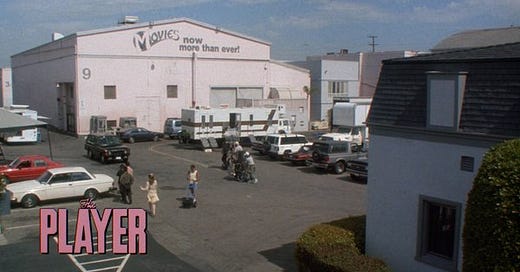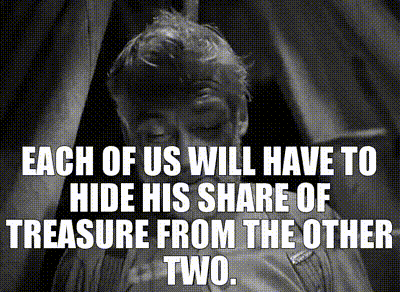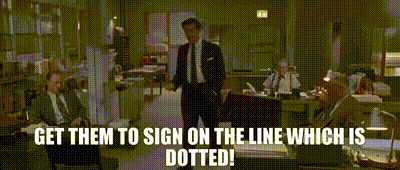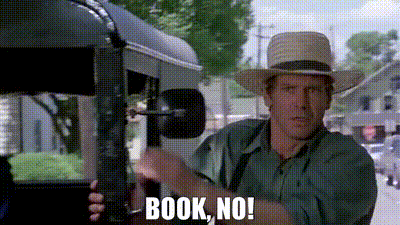And the Strike Dragged On...
A layman's guide to understanding writer deals, and why writers are on strike
There’s an old Hollywood saying that goes like this: Everyone has two businesses, Show Business and their own.
In that spirit, I note that lately there has been a lot of chatter on my social media feeds about the ongoing WGA Strike, all of which generally breaks down into two categories… the first category is comprised mostly of “a pox on both houses” posts. While the second category often features well-meaning posts that get basic facts wrong in an attempt to understand what’s going on.
So, I thought I would walk my readers through the basics of writer deals in hopes that we can all understand the issues behind the strike a little bit better. Perhaps these details will change your mind about the strike, and perhaps they won’t. But if nothing else, you’ll be able to sound smarter than all your friends at your next cocktail party.
So… why are the Writers striking?
Well to start with a very basic answer, they are striking over the WGA Minimum Basic Agreement, or the MBA. The MBA is a contract which outlines the bare minimum that WGA Guild Signatories (basically every studio and network in Hollywood) must pay WGA Writers for a variety of different types of contracted work. Each MBA remains in effect for three years and must be re-negotiated at the end of each term. Within every MBA, there are automatic rate hikes for each of the three covered years such that, by the end of the term, the minimum fees are all higher than they were when the term began.
Who is covered by the WGA?
Essentially, everyone who is paid to write for movies or TV is covered by the MBA. No Guild signatory may hire non-WGA writers. Any production entity who wishes to hire a WGA writer must first become a Guild signatory. Similarly, no WGA writer may write for a non-signatory. Any first-time writer who is hired to work for a signatory must immediately join the Guild, and the contracting signatory must pay them no less than Guild minimum. Also, in addition to the fees signatories pay writers, they are also required to pay into the WGA’s pension, health, and welfare fund as part of each writer’s deal.
As far as enforcement mechanisms go, the Guild keeps a black list of companies who have broken any of these rules and no WGA member may write for any of those blacklisted companies. Additionally WGA members who write for non-WGA affiliated or blacklisted companies can be black-balled from the Guild.
Now… let’s go through the components of a basic writer deal so we can understand how they work. I’m going to focus primarily on Feature Film Writer Deals here, because they tend to be a little simpler than TV deals (writers “produce” TV shows as well as write them, which complicates things). But just know that the underlying assumptions of the WGA MBA are essentially the same for both TV and Film writing, even if some of the terminology is different.
Writing Deals are made up of “steps.” Each “step” triggers a payment to the writer. The various Feature Films steps, as outlined in the MBA, are “Treatment” (sometimes referred to as “story” in the MBA), “Draft” (or First Draft), “Rewrite”, and “Polish.”
THE TREATMENT
A treatment is basically a detailed outline. It can include prose, stage direction or sample dialogue, but it is essentially a beat-by-beat description of the movie that the writer will write. There’s no industry standard for length but I’ve seen 3-page feature film treatments and I’ve seen 60-page treatments. Longer treatments are sometimes called “scriptments".”
Here in 2023, the treatment step has almost completely vanished from writer deals. Why it has done so has been an ongoing WGA complaint for at least 20 years.
The crux of the problem is that there are so few studio writing jobs, and so many writers trying to get them, that writers are being asked to do a tremendous amount of free work just to put themselves in contention. For most writers this includes creating a detailed document… writers call these “pitch documents”, but they are often indistinguishable from treatments. A good lawyer or agent can sometimes get the studio to pay for this document after the fact, but not always.
Regardless, writer deals that include a treatment step are rare and getting rarer. And given that Guild minimum for a treatment is anywhere from low to mid-five figures depending on the budget of the film and whether or not it is an “original” idea, this represents a not insignificant loss of revenue for writers across the board. Here’s another way to think about the magnitude of this revenue loss… a treatment for an original movie with a budget above $5 million, basically the majority of all movies in development, would pay a writer something like double the median U.S. income of $31,000.
THE FIRST DRAFT
The first draft is the most lucrative step in any feature writer deal. A rule of thumb is that a “rewrite” pays two-thirds of a “first draft.” So if you’re being paid $75,000 for a rewrite, you should expect to get $100,000 for the first draft. In practice that gap tends to be a little bigger but for our purposes, two-thirds is a good benchmark (Remember that calculation because it’s going to become very important later on in our discussion of A.I.). Guild minimum for a first draft, again depending on budget and whether or not the screenplay is an original or an adaptation, can range from mid-five figures to low-six figures.
THE REWRITE
The definition of a rewite (sometimes called a “revision” in the dealmaking process) should be obvious, though it’s worth mentioning that many writer deals include multiple rewrite steps, usually designated as “first rewrite”, “second rewrite” and so on.
The MBA does not contemplate different kinds of rewrites, but in practice, agents and lawyers negotiate a writer’s rewrite fee based on how much work they are being asked to do. As a result of having to thread this needle, agents and lawyers have come up with terminology that doesn’t appear anywhere in the MBA… specifically the “Page One Rewrite.” This is to protect writers from getting paid rewrite numbers for what might be a total tear down of a script, essentially a complete start over, which would arguably constitute a first draft in practice. Again, in general, rewrites pay about two-thirds as much as a first draft (though rewrite fees often get smaller for subsequent rewrite steps when there is more than one), and like every other writing step, Guild minimums for a rewrite are budget-based.
THE POLISH
A polish is a small rewrite, something that doesn’t dramatically affect the characters or structure of the screenplay, so named because it’s only meant to “polish” the final rough edges off the script. You may have heard them called something else… like a “comedy punch-up” or a “dialogue or character pass”, but the Guild calls it a polish. This step comes with a relatively small minimum fee attached, low five-figures depending on the budget.
NOTE: Typically writing fees are split in two with half the total fee for a given step paid on “commencement” of the step and the balance paid on “delivery.”
GUARANTEED VERSUS OPTIONAL STEPS
The language of writer deals is written in terms of “guaranteed steps” and “optional steps.” Obviously writers, and their agents and lawyers, always want as many of the steps to be guaranteed as possible, and the studio always wants as many of the steps to be optional as possible… who “wins” in these cases is determined in the negotiation process. But generally at least some of the rewrite steps are optional, though a good agent or lawyer can often push that threshold back to the polish stage. Whether or not an optional step is “exercised” is solely at the discretion of the studio or network.
MISCELLANEOUS STEPS
There are a few other kinds of steps that are not really an underlying cause of this strike but which I’ll mention in the interest of being thorough. When a writer is brought in to work on a script on a week-to-week basis we call that a “weekly” and the writer is paid a negotiated weekly rate. When a writer is brought in to be on call throughout the production of a movie, to do continuous rewrites on set, we call that an “all services” deal and, again, the writer is usually paid a negotiated weekly rate, often with a minimum and maximum number of guaranteed weeks.
ORIGINAL VERSUS ADAPTATION
There is one last thing we have to discuss before we can get into the meat of what’s got everyone so pissed off this summer, and that is the MBA definitions of original screenplay and adapted screenplay. You’ve probably noticed, if you’ve watched the Oscars, that there are separate categories for “Best Original Screenplay” and “Best Adapted Screenplay.” This is because Hollywood decided long ago, in partnership with the Guild, that writing an original screenplay and adapting one from a book (or other underlying material) are two diferent jobs. The latter pays a little less than the former because, in the case of an adaptation, a writer generally has the characters and major plot points already created for them. This is not to say that adapting a novel is easy… it isn’t… in fact in some ways it’s much harder than creating an original screenplay. I make no value judgments here, I’m only telling you how the Industry looks at the issue.
Whether a screenplay is an Original or an Adaptation also has implications for how credit is awarded to writers via the WGA when multiple writers work on a movie (as well as a few other things), but for purposes of simplicity, I’m not going to get into any of that here.
THE STRIKE
So… why are the Writers on strike, and why does this strike seem so nasty?
Well, every previous MBA negotiation between the WGA and the Studios (known collectively as the AMPTP) has been primarily about money. Money issues are great in negotiations because they are easy to understand and there is almost always a middle ground, if you can find it.
In some ways, the 2023 MBA negotiation started out no differently than any other. At its heart this negotiation too is about money. The WGA wants all those minimums I outlined above to go up, especially at the streamers where TV budgets have ballooned well beyond anything the Networks imagined in their wildest dreams. They also want the AMPTP to increase their contributions to the WGA Pension, Health, and Welfare funds.
The TV writers are making a few other demads that are (for the purposes of this essay) too esoteric to dig into. They want better SPAN Protection, for one thing (look it up if you’re curious). Also, while movies are typically written by a single writer working alone, TV shows are written and produced by working groups of writers called “Writers Rooms”. Each room is “run” by a senior writer called, approrpiately enough, a “Showrunner.” TV writer rooms have been getting smaller and smaller over the last few years, and streaming series generally produce only 8 or 10 episodes per season instead of the typical network schedule of 22, so the WGA is looking to impose on the Networks and Streamers a minimum writers room size to protect as many jobs as possible.
But again, all these issues are relatively simple, if not easy, to negotiate. (here is a Business Affairs Executive contemplating how the Writer Room Size issue might be solved)
Unfortunately, or fortunately depending upon your point of view, we live in tumultuous times for Hollywood. Technology is changing the way movies and TV shows are made and exhibited in ways no one could have predicted just a few years ago, and it’s all happening too fast for anyone in this town to easily adapt to… certainly it’s moving way too fast for a contract that only gets re-negotiated every three years. This radical technological change has created two major issues that are really at the heart of all the nastiness we’re seeing in the context of this strike. Issues which are novel and existential and which don’t have an obvious monetary solution. These are, in no particular order, Streaming Residuals and Artificial Intelligence (AI).
STREAMING RESIDUALS
In discussing the WGA stike, I’ve seen a lot of folks on Twitter (or X now, I guess) conflating Residuals with Backend… this makes sense because both residuals and backends are mechanisms designed to do largely the same thing… to allow writers (and directors and actors) to participate in the revenue generated by the movies and TV shows they create.
How these different mechanisms achieve this result is critically important and reveals them to be radically different tools for achieving (or in this case failing to achieve) a similar goal.
Residuals are paid on the basis of a fixed formula. This formula is agreed to solely by the WGA and the AMPTP and only changes, if at all, when the MBA is re-negotiated every three years. Residuals are not negotiable by individual writers on individual deals and, in fact, the laywers and agents who negotiate writer deals do not commission residuals.
Think of residuals like interest payments on a savings account. The bank takes your balance, multiplies it by your interest rate, and deposits the resulting number into your account automatically. The interest rate is fixed and rarely changes, if at all. You cannot negotiate for a better interest rate every time you deposit money into your account.
Critics will interject here to point out that fixed residual calculations are based on “use” and do not require a profit calculation…. meaning a network or studio must pay you a residual every time they “use” your material, regardless of whether they profited from it. While this is true, obviously you cannot have a conversation about paying residuals unless you have a basic understanding of how much revenue a piece of content generates on a particular platform. In other words, just as it’s unfair to pay writers less than they deserve, it does nobody any good if entertainment companies go bankrupt paying residuals.
But here we see a major problem with the streaming model, one that is almost entirely the fault of the streamers themselves, who guard their viewership data jealously… that it is extremely difficult to caluclate the value of a single subscriber watching a single episode of a show or a movie when that subscriber pays a low monthly fee for unlimited access to as much content as they can consume. But let’s assume, for a moment, that we could calculate a fair minimum use rate for an episode of streaming TV. In that case the WGA would have to at least consider the possibility that the resulting amount would be damned near zero… and the streamers’ refusal to release their viewership data is increasingly viewed as damning evidence that this is the unfortunate reality of the streaming model.
This is the biggest problem we’ve had with streaming from the very beginning… that it was never clear how an individual show or movie would generate revenue specific to that piece of content. Most lawyers and agents would have said that it was going to be tough to get writers paid on the backend, either by residuals or by profit participation. And many reps did say that to their clients. But the problem was that in the middle of the gold rush that was the streaming boom, few were listening. There were too many jobs on too many cool shows paying too much money and, like the actual American Gold Rush (also known as “Gold Fever”) people made decisions based on short-term thinking, and some of those decisions turned out to be bad ones. Now, some of those same people are waking up with a hangover as they look at their dwindling residual checks and wonder what the hell happened.
If residuals are the Collectivist top-down one-size-fits-all solution to profit participation, a writer’s “Backend" (so named because these fees are paid at the back end of the deal, as opposed to the writing fees which are paid at the front end) is the Adam Smith pure Capitalist version. Adam Smith described Capitalism as a highly-efficient system where everything from pricing to supply and demand are determined organically by millions of individual transactions made freely and voluntarily between willing buyers and sellers throughout the economy each and every day. And so as you would expect from a system that has been built by, and continuously evolves via, thousands of individual negotiations every year by the most creative and aggressive lawyers and agents in the business, there are as many ways to skin a backend deal as there are writers in the Guild.
For example, backend calculations for feature film deals can include one, some or all of the following: credit bonuses (a writer typically receives one amount for “sole” credit, and half that amount for “shared” credit), green light bonuses, production bonuses, bonuses for award nominations and/or wins, box office bonuses (which can be based on domestic B.O., worldwide B.O., or on multiples of the budget), and profit participation, which includes a variety of definitions from “net profit” to “dollar one gross” and every conceivable permutation in between. Backend deals are fully commissionable by lawyers and agents and so there has been decades of institutional incentive for representatives to be creative as possible in the service of finding ways to maximize thsese numbers for their clients and themselves.
TV writer backend deals are a little different. But even though they use some different terminology, they can also include some of these same bonuses and they typically employ a profit participation calculation, just as feature deals do.
Backends are a merit-based calculation, in that a writer’s stature in the business and their track record for writing movies or TV shows that get made determines how big their backend will be. For most writers a backend operates like a see-saw… meaning as one end goes up, the other typically goes down. Top end writers often have a choice as to which end of the see-saw they would prefer to be higher, and Hollywood is full of stories about artists who took less money up front, bet on themselves, and hit the jackpot.
This is critically different from the way residuals work which, as I’ve said, are based on a fixed calculation. The “best” writer in town gets exactly the same residual calculation as the “worst” writer in town.
Calculating backends in the world of streaming has been just as challenging as calculating residuals, but by virtue of the fact that strategies for backend calculations are constantly being revised and evolved by hundreds if not thousands of daily negotiations, streaming backends (which, for now, have generally been replaced by backend buy-outs on the front end) have generally paid much better than streaming residuals.
Much of the uglines of this strike has been a symptom of the underlying reality of collapsing streaming residuals alongside the streamers’ reluctance to reveal the viewer data that might make it easier for the AMPTP and the WGA to arrive at a more equitable formula for paying them.
ARTIFICIAL INTELLIGENCE
The confusion over the WGA A.I. fight is best described by a question I got on Twitter… “is the WGA actually worried that they will be replaced by A.I.?”
The answer is… sort of.
And whether or not you agree depends on whether you think it’s a short-term problem or a long-term one.
In the short-term, I believe the answer is no, with a but.
There is some concern in the short-term that some of the writing steps that are currently done by humans, and which generate significant fees, could be taken over by A.I.
Imagine a long-running formulaic show like a police procedural that has been airing 22 episodes every season for ten years. It is possible that for a show like this, the Network might be able to put all of the previous episodes into an AI program and ask the system to generate new scripts featuring ripped from the front page crime stories. And then even if the scripts are bad, a room with just a couple of human writers in it could revise those scripts and get them into production shape without the need for a full-sized room of ten or more writers.
There are similar fears on the feature film side.
Remember when I pointed out that the treatment step has become a rarity in feature writer deals? Well, there is a concern that A.I. could make them disappear completely. The idea is that Studios could feed basic prompts into a machine and produce a treatment that hits all the basic plot and characters points of the movie they want to make, even if the resulting document would feature none of the artistry typically associated with screenwriting.
But like David Mamet’s “line which is dotted”, the studios would argue that this a blade which is double-sided.
They would say that a writer can use A.I. for the same advantage, to remove the grunt work of writing. A writer could feed prompts into the same machine and get the same treatment that might take them 2 weeks to write in thirty seconds or less. And then all that would remain would be some basic editing and the addition of the writer’s “voice.”
As proof that both arguments can be true at the same time, an executive friend of mine fed the following prompt into ChatGPT… “A tough-as-nails detective must hide out on an Amish farm to protect a young Amish boy who witnessed a murder.” What he got back could very well have been the actual treatment from the 1985 Peter Weir thriller WITNESS. Even the kid’s name, Samuel, was the same.
A much bigger problem for the WGA and its members concerns the fate of the “first draft.” Earlier I pointed out that a rewrite generally pays a fee that is two thirds of an original. Well, let’s say Warner Bros wanted to make a Superman movie, and so they fed all the Superman comic books, as well as all previous drafts of Superman screenplays they have commissioned over the years, into an A.I. program and then asked it to generate a script for a new movie. Again, as with the TV example above, even if the resulting script was bad, they could then submit this “bad” script to a well-paid, talented screenwriter and ask them to “rewrite” it. In this way, theoretically, the studio could save 30% on writing fees by avoiding the “first draft” step altogether. The fear within the WGA is that, in an environment where writer salaries have already been on the decline for some time, this would cause a further and immediate 25-50% reduction in writer fees across the board.
There are some legal questions about whether or not the studios could use copyrighted material in this way, even if it was work for hire material that they own, and several law suits have been filed recently that seek to give real teeth to this very argument. Nevertheless, it remains a real concern for the Guild.
As for the long term… can machines replace writers entirely?
Here I’m going to take a contrarian view and say not just no, but hell no.
I don’t care how many prompts you feed into ChatGPT, you will never get the screenplay for BUTCH CASSIDY AND THE SUNDANCE KID, or THE MAGNIFICENT SEVEN, or ALL THE PRESIDENT’S MEN, or THE GODFATHER, or THE BIG LEBOWSKI, or WITNESS or a million other classic films… not ever.
And it isn’t just the fact that these movies are based on brililant screenplays which makes them great… it’s the combination of a brilliant screenplay and a genius director and talented actors and tradesmen all working together at the peak of their abilities which produces great movies (and TV shows). To believe otherwise is to believe that there is no devine spark of human creativity… that human emotion, the human soul, can be replaced by machines… and I simply won’t accept that.
This is a ship I will go down with.
Nevertheless, my Rennaisance Man pronouncements about the irreplaceable quality of the human soul aside, this is where we find ourselves here at the nearly 100-day mark of the 2023 WGA writer strike. There has been some news this week about the AMPTP reaching out to try and get the WGA to return to the negotiating table. As I write this, the mood around town is cautiously optimistic and the WGA and AMPTP are set to have “a meeting about another meeting”, as industry wags have put it. But as with most things these days, the best one can say is “we shall see.”
If nothing else, at least you are now well-equipped to both understand the issues at stake, and to explain them to anyone who might ask.
Or, failing that, to argue with randos on Twitter.
You’re welcome.










I've always thought underlying issue of the strike was the TV/Movie world was changing and nobody is quite sure what it is going to look like in 5 years let alone 10. Hell streaming is different today that it was 2 or 3 years ago. It is hard to make a fair deal (and everybody's idea of fair is different) when nobody knows what the future is going to be.
going to post this and then subscribe. As I promised, just late. Been busy.
Movies are the hardest of all art forms because of the complexity. For a movie to be great everything, and I do mean everything has to work just so. Script, cast, director, editing (especially the editing) filming, sound, the hundred of people whose name you don't recognize as the credits zoom by at warp speed. If one of those things is not so good you can still have a good movie, but not a great one. If several are off the movie can be enjoyable to watch but not great or maybe not even so good.
The writing is a part but no more so then the others. It's the starting. The foundation or the hole that the foundation is poured into, but that's it.
The trouble with the writing is it's all the same. Take Superman which you brought up. Superman has been around since the 1930's and has a entire slew of villains. A cast of 100's. But in a Superman movie, what you do you get. Lex Luthor,, and in the reboot, Lex Luthor, and in the reboot of the reboot, Lex Luthor. Probably in the boot of the next reboot of the previous reboots., Lex Luthor. In the JLA movie they had someone else, not great movie but at least it had that. Substitute Batman and The Joker and same thing.
The reason AI looks good to the studios is it's just what they are getting now from the writers. Second verse, same as the first!
Usually the only thing different. in the James Bond movies is the Bonds. haven't I've seen this movie before? Probably yes. You kind of expected that in Westerns. Till it changed.
There are a lot of stories out there that would make ( I think) good movies. Commercially viable?? Another story.. But what do we get from the studios. Mostly woke nonsense that no one goes to see. Hello Disney, hello, hello Warners, hello! It's a rare movie that actually makes any money and it seems that both the studios and the writers don't want to write the ones that do.
The movies that you mentioned are the great ones. But when I look around at what the studios are producing. I'd go with AI